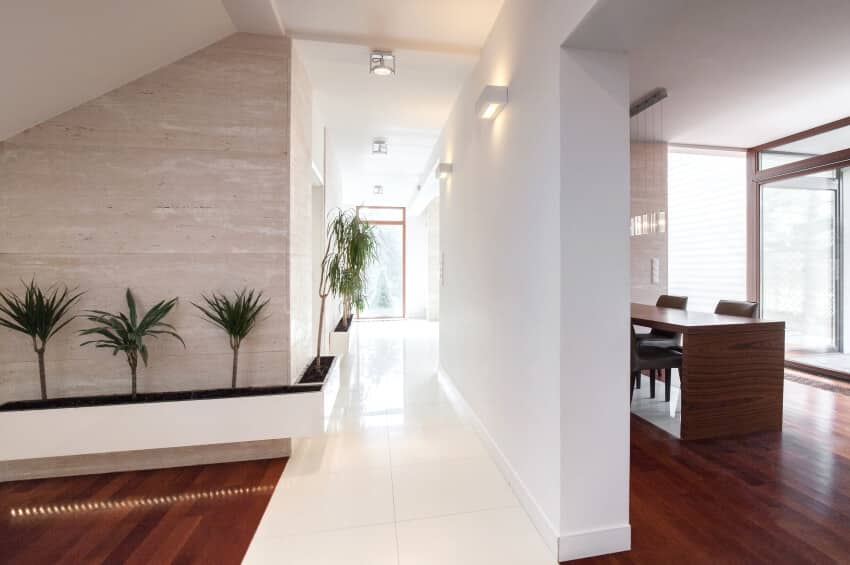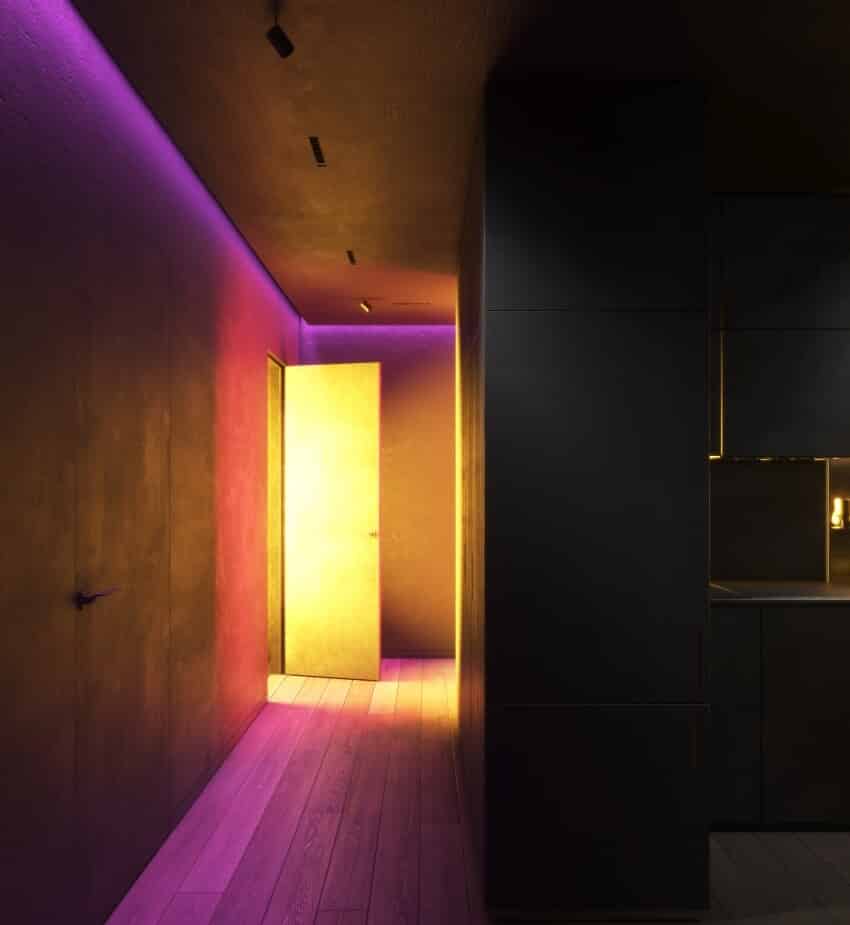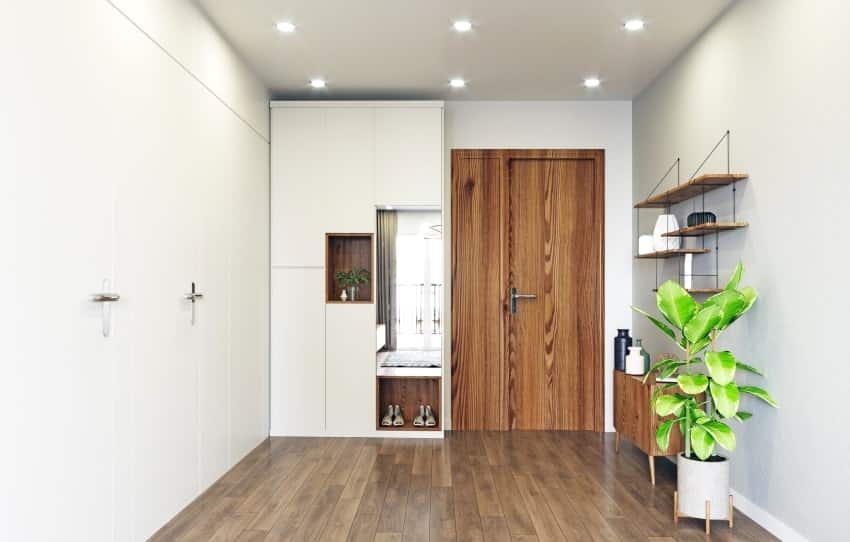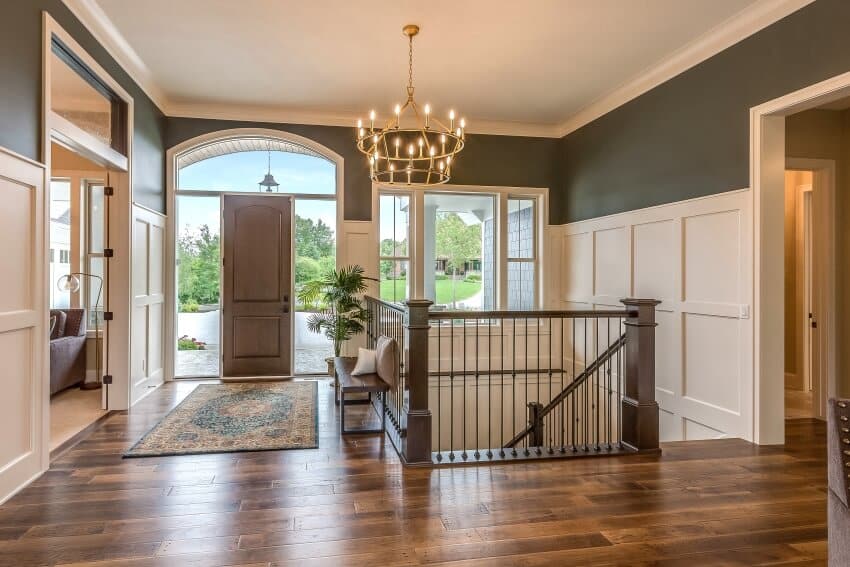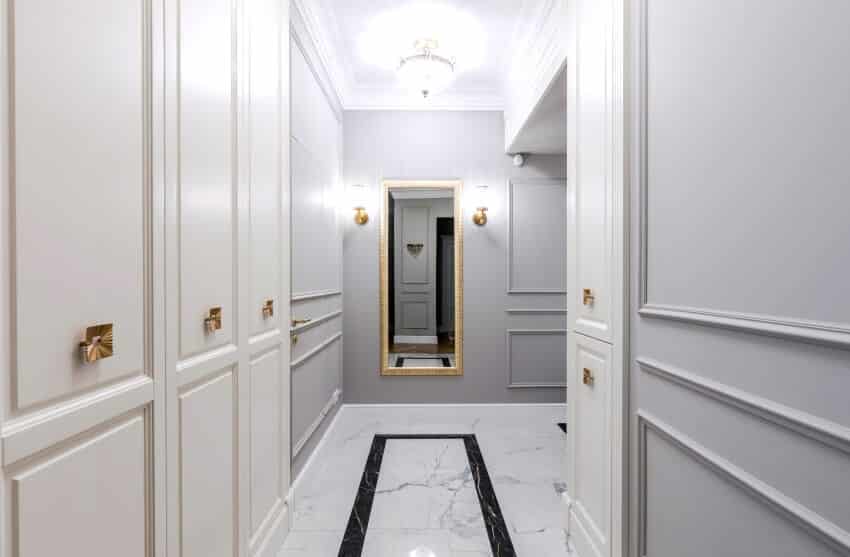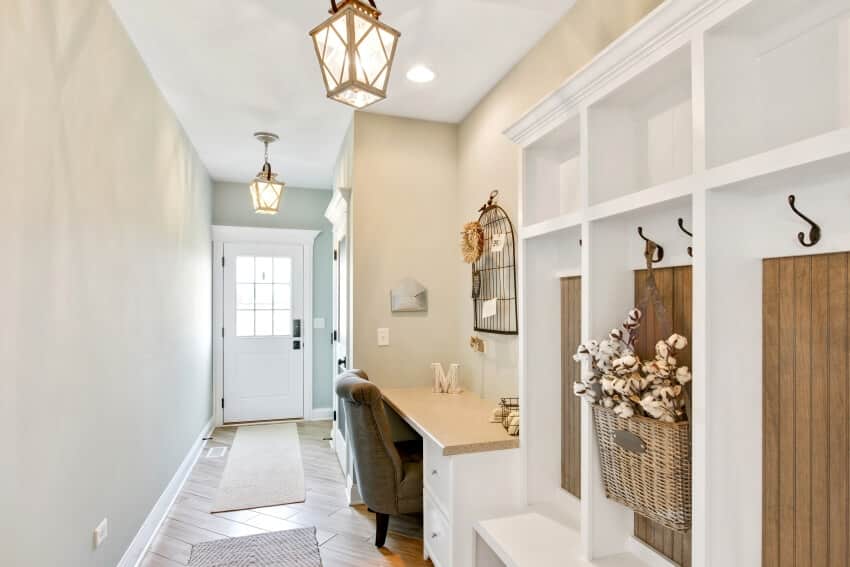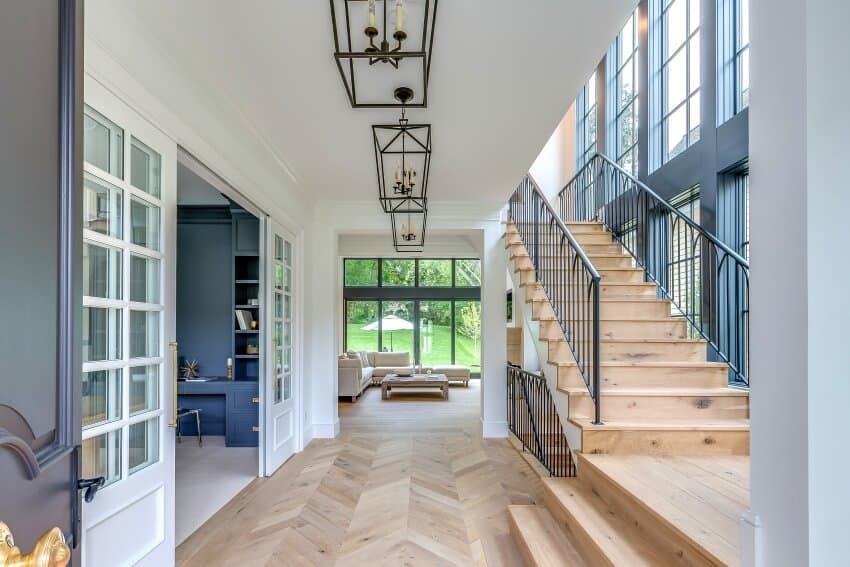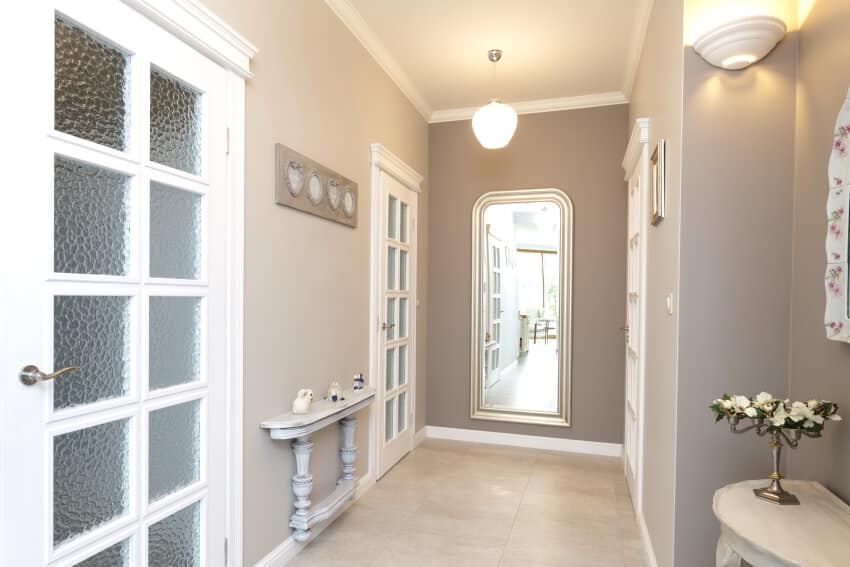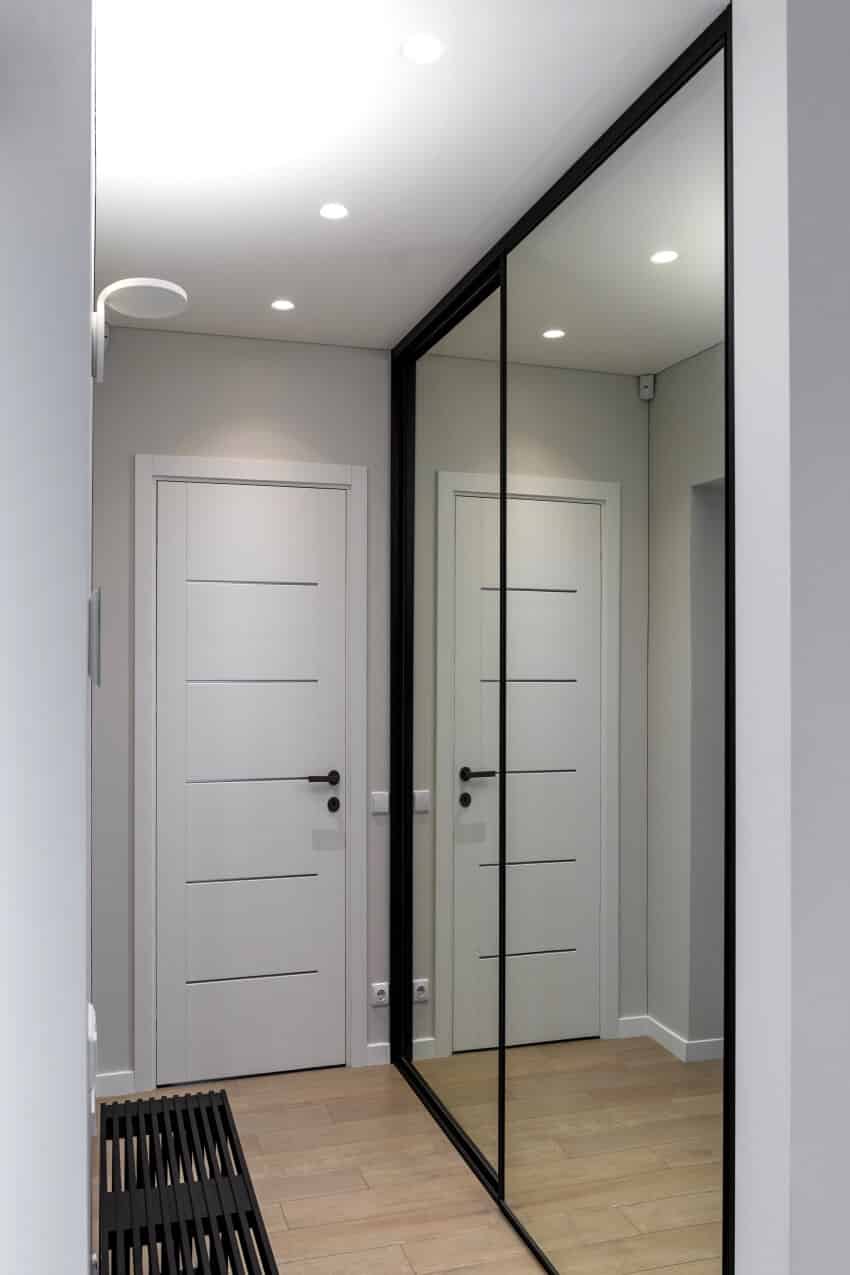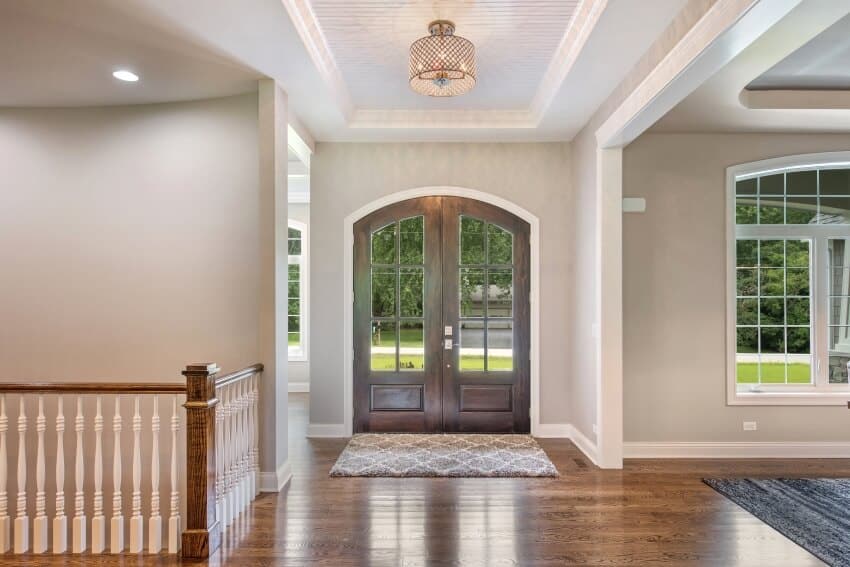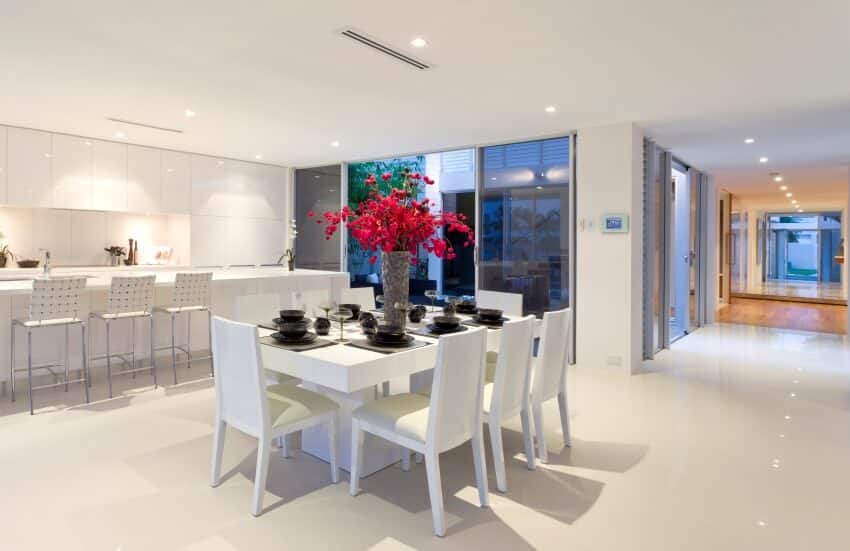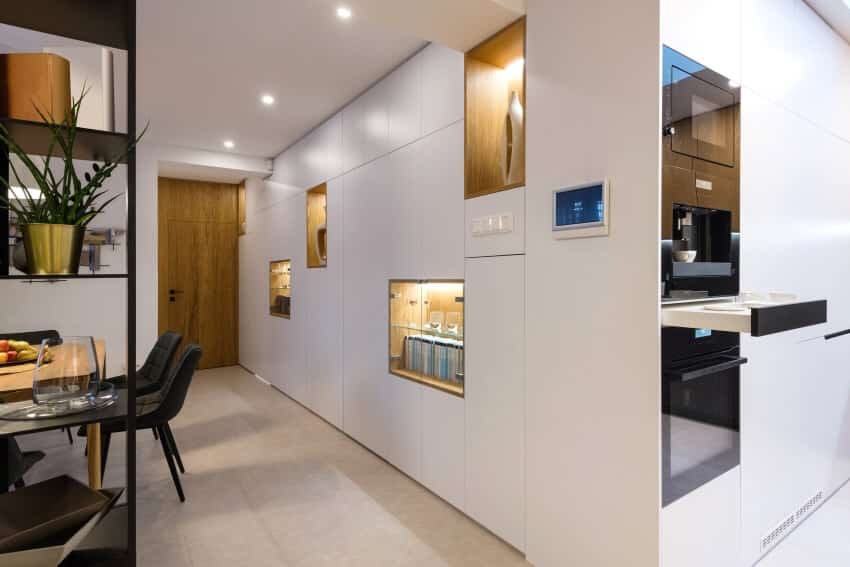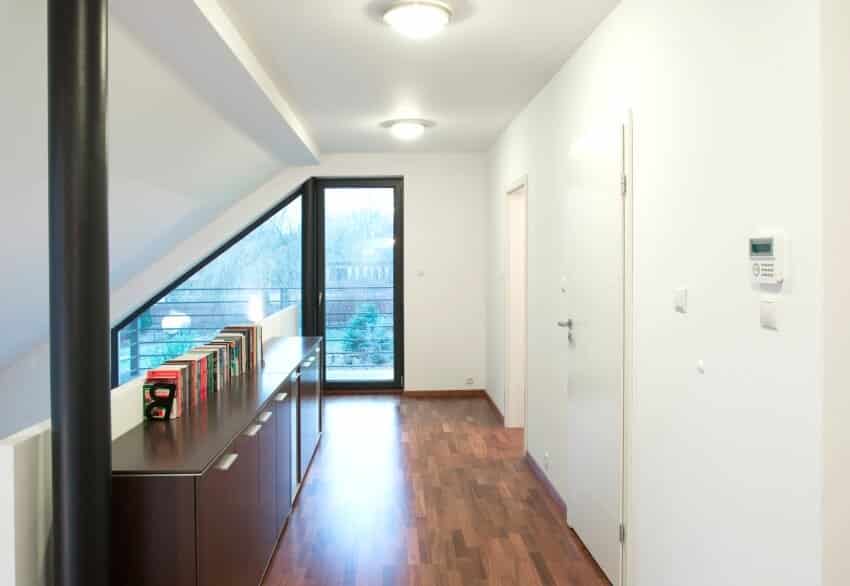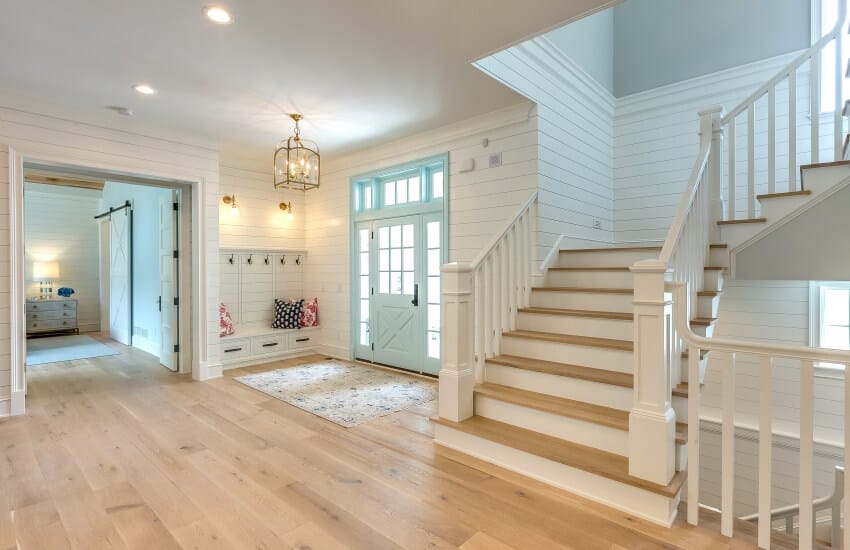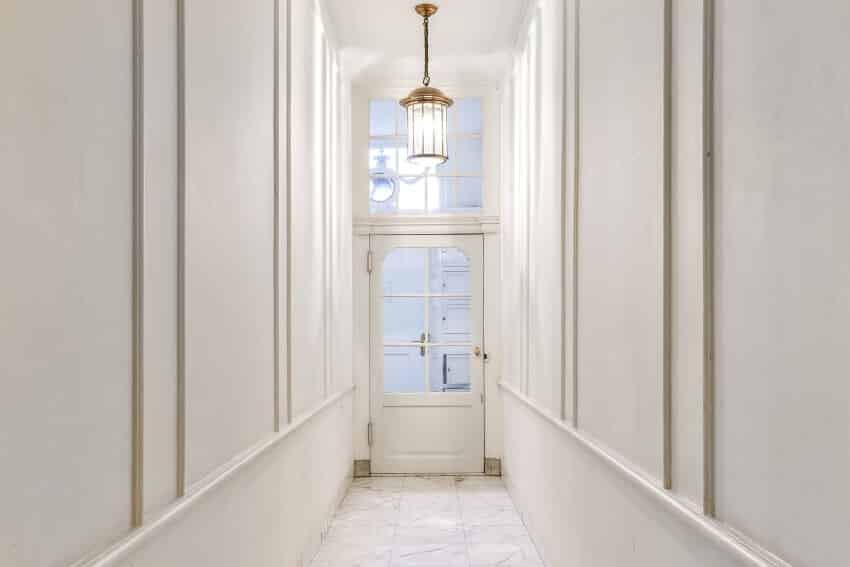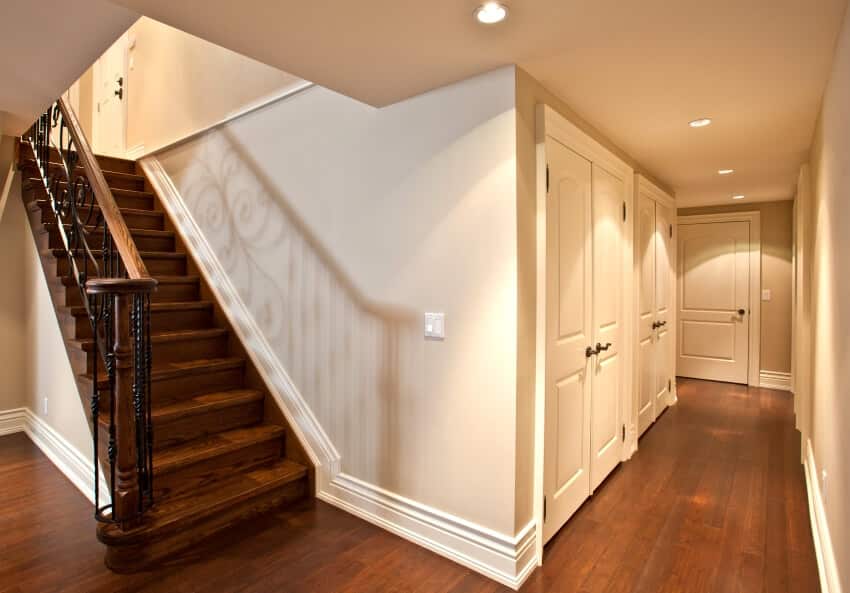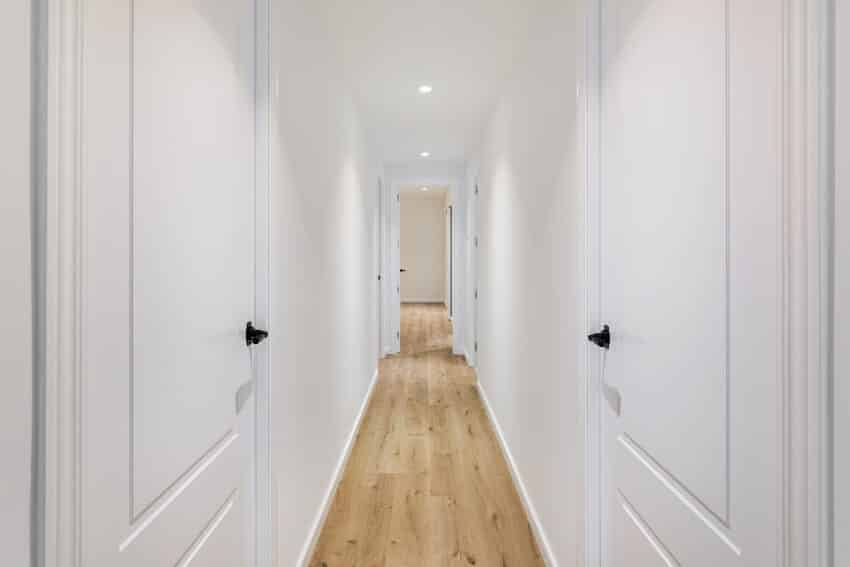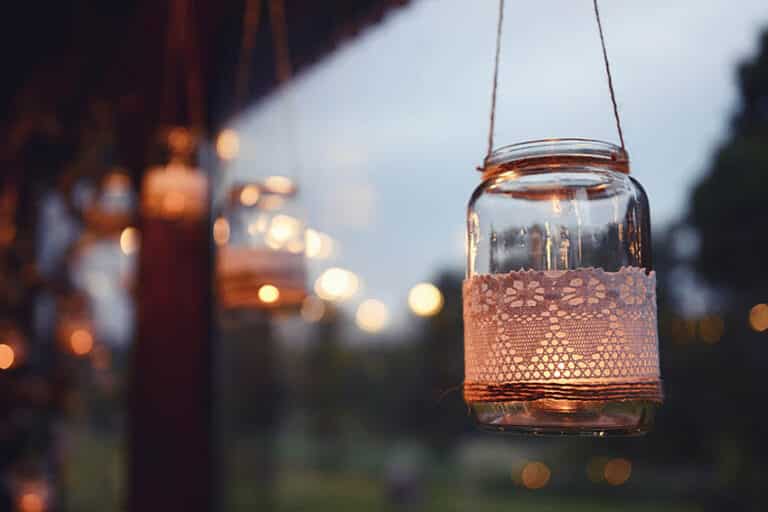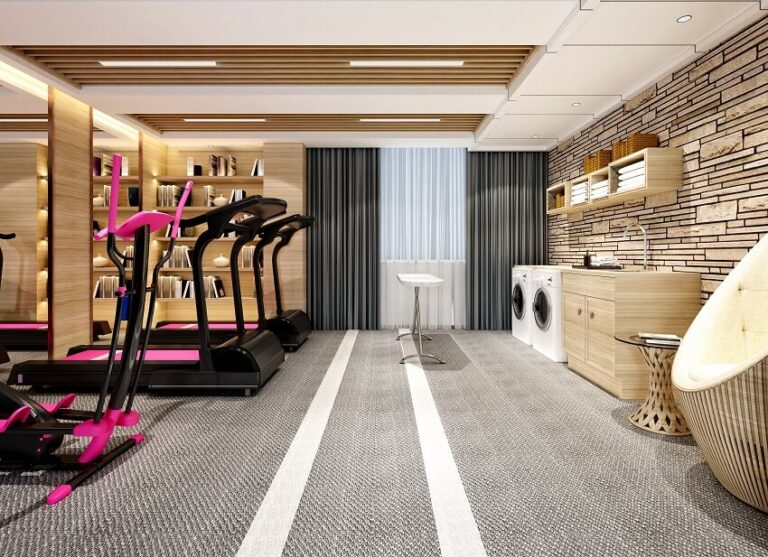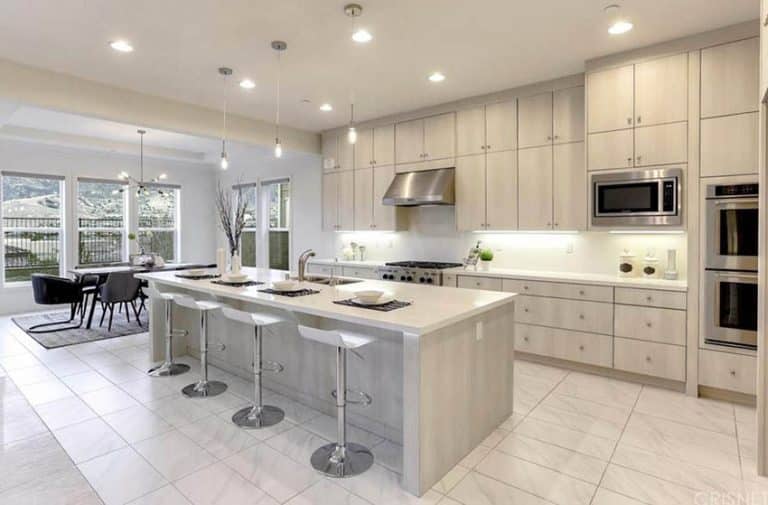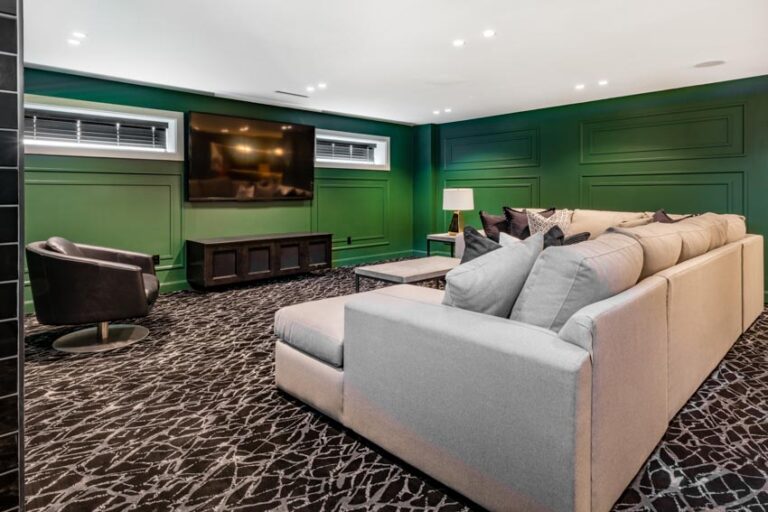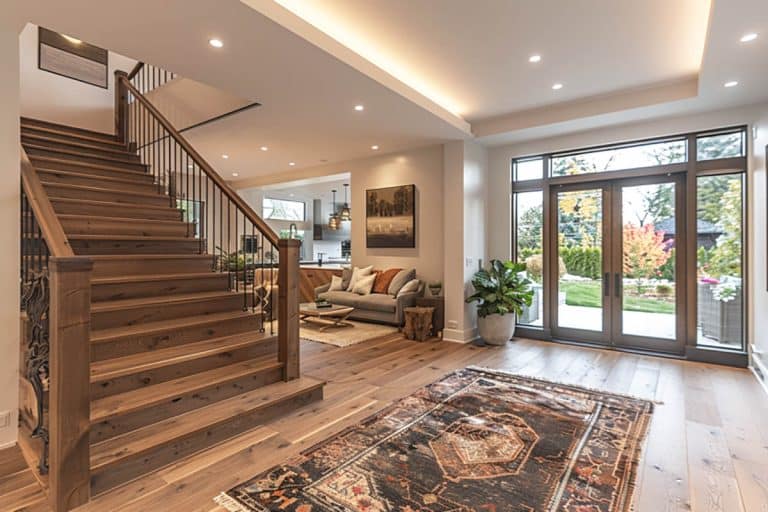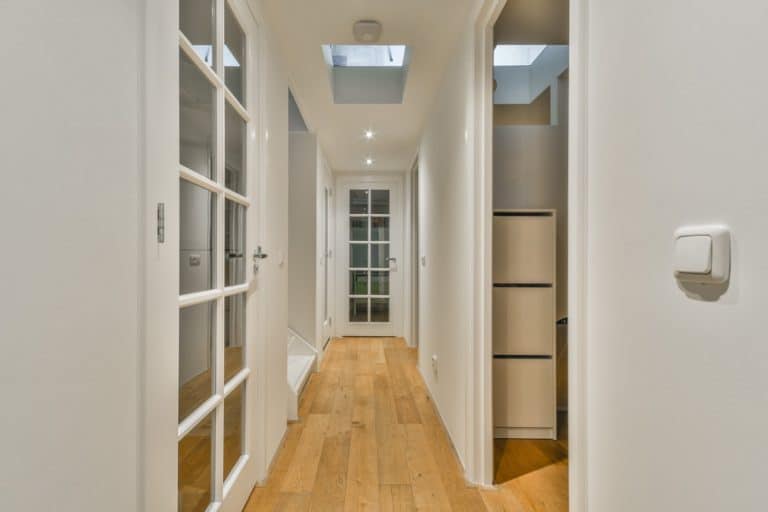Hallway Lighting Ideas (Light Fixtures & Design Tips)
Experimenting with different hallway lighting ideas is the trick to perfecting your hallway space. You want to make the perfect entry to your home, but let us face it – hallways are sometimes neglected when creating and adorning the space.
You can appreciate how elegant and functional corridor illumination can be and how it can enhance even the smallest space in your house.
Whether you have a dreary entry hall that requires a creative lighting arrangement or you are looking for a more contemporary display lighting fixture to be a central focus of your space, we have got the greatest hallway ideas covered.
Types of Hallway Light Fixtures
Recessed, track, flush, semi-flush, and sconce lights are the most popular hallway light fixtures. Here’s a breakdown of each type.
Recessed Lights
Recessed lighting is commonly installed in a hallway’s ceiling to provide the illusion of concentrated or scattered illumination beaming from an opening or hole. These types of light fixtures have the advantage of being able to be concentrated at a certain angle, allowing for ambient mood.
Furthermore, since they normally require drilling an opening in the ceiling, these hallway lights may be too complex for DIY projects. If a homeowner prefers recessed lighting in their hallway, it is usually a much better decision to ask for professional assistance.
Track Lights
Track lighting is also another type of foyer fixture that is commonly employed when recessed illumination is not available. This type can make wiring for several lights connected to a track so much easier.
It entails mounting track hardware on a wall or ceiling and linking it to a power supply. Multiple fixtures can be fitted to different parts of a track after it has been installed.
Flush & Semi Flush Lights
These are typically a dome-shaped ceiling light that can be flush with the wall or extend a little below the ceiling. Generally, a semi-flush mount light fixture is a more decorative option.
Both the flush and semi-flush fixtures are popular throughout many rooms in the home. We’ll cover both of these in more detail below.
Hallway Wall Lights
 Sconce
Sconce
A stylish sconce or wall uplight is an excellent selection for brightening your hallway with interesting light fixtures. Whether the style you prefer is modern, vintage, or mid-century classic, you will undoubtedly find the perfect sconce for your hallway.
Wall sconces enhance the beauty of your home, specifically your hallways, by adding a decorative touch to your plain walls. Sconces can produce a substantial quantity of light in your hallway, but it is their subtle elegance that makes them an outstanding pick for modern interiors.
You can look for an uplight sconce if you want a fixture that reflects light upward towards the ceiling. These eye-catching lights work perfectly with the hallway’s current ceiling lights.
Spotlights
Spotlights are a contemporary type of design. To make a hallway well-illuminated, multiple spotlights are mounted on a bar or track that can be attached to the hallway ceiling. The spotlights may provide both ambient and task lighting. Most spotlight bars enable users to change the orientation of individual bulbs, allowing them to customize these spotlights to their liking.
Spotlights will consistently be a desirable option in terms of functionality. They can generate directional illumination on the walls or areas below. This is a crucial light source in a hallway since it ensures you can see things properly from the time you step within the house, specifically in the dark.
Lights that are focused on a specific area, like these are important in hallways as they are extremely helpful in terms of security in the sense that the entryway is bright enough to give your guests notice on the doorstep.
Hallway Floor Lights
You can consider installing hallway floor and baseboard lighting for a more unobtrusive solution. Such options are perfect for lighting up your stairway at night or filling your hallway with moderate ambient illumination.
Moreover, this is another approach to obtaining the polished appearance you desire for your home by paying attention to structure and exquisite finish work. Furthermore, these floor lights effortlessly fit into the aesthetic of the room, complementing various hallway fixtures and décor.
Table Lamps
A table lamp is a light fixture that sits on a table or other piece of furniture. Table lamps are among the most basic illumination options in the lamp family.
Contemporary- or modern-style table lamps, with the right bulb type, cover, form, and color, can supply concentrated or scattered light to accentuate the mood of the space, even hallways.
One feature that all table lamps share in particular is their mobility — they provide convenience and can be easily relocated from one spot to another. Plus, you will not need the assistance of an electrician to install a table lamp; they merely come with a simple cord and plug.
Nowadays, you can even see wireless table lamps that have further removed the usage of cables, cords, and plugs.
Specialty Lighting Options
There are some fixtures with special options such as smart features, motion sensors, and battery operated that provide additional functionality.
 Smart Lights
Smart Lights
Smart lighting is a cutting-edge method of light for your hallway. Smart innovation allows your hallway’s lighting systems to expand their coverage, performance, and functionality. In the simplest sense, smart units can be managed remotely, usually through an application on your smartphone or computer, removing the requirement for conventional wall-mounted switches.
Smart lighting often depends on various sorts of wireless communications to transmit and acquire signals to work. It can link to your smart home system via built-in Wi-Fi transmitters or Bluetooth.
Several forms of machine learning methods are also used in some of the most powerful smart lighting setups. The lights continuously watch and memorize the sequences of individuals walking down the hallway.
This type of learning enables them to switch on and off periodically at particular times of the day based on the residents’ daily behaviors, creating the sense that residents are at home even when the house is unoccupied for longer durations.
Motion Sensor Light
Several smart lighting solutions in the hallway include motion and light detectors that switch on and off based on the quantity of brightness sensed or the proximity of individuals and activity in a certain place.
Such simple features can help prevent energy loss caused by mistakenly keeping them on when the house is unattended. See our guide to the types of motion sensor lights here.
Battery Operated Lighting
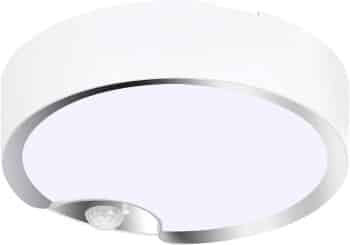
Battery-powered hallway lights do not require wiring or outlets because batteries drive them. They do not require a complicated installation method and can be used well in hallways.
The battery-powered lighting system has traditionally been used in emergency situations and power outages, but as technology progresses, the application of battery-powered lights in homes and workplaces has grown. Many homeowners prefer applying these portable battery-operated fixtures in their hallways as they are easy to move anywhere.
LED lights, or light-emitting diodes, are commonly used as battery-operated fixtures that could be installed temporarily or indefinitely, depending on the user’s needs. The battery-powered LED lights come in a variety of sizes and forms.
Battery-powered hallway lights run at such a low voltage that even a minor shock is rare if the system malfunctions. LED lights do not generate heat, making them ideal for indoors against fabrics. This means you can be confident in meeting health and safety rules for venues or simply have peace of mind in your hallway.
Night Light
A night light is a compact electric fixture used for convenience and reliability in dark areas or locations that may turn dark at specific times, such as at nighttime or amid an incident.
A hallway night light is often a low-power electric unit that is turned on at night to allow you to walk safely in your hallway. They offer sufficient light to see the lines and shapes of things inside a hallway while remaining dim enough to avoid overwhelming or blinding you. Night lights are frequently used to provide comfort to youngsters who are terrified of the dark.
What Light Bulbs Are Good For Hallways?
LED hallway lights or any LED bulbs are extremely ideal for basic hallway illumination. They are installed on the walls or the ceiling and emit diffused radiance in all areas.
This implies that the light cannot overwhelm individuals. LED battens and wall lights are more suited for broad hallways because of their size.
Moreover, LED bulbs not only have extended life expectancy but are also economical and necessitate minimal management and maintenance. This not only allows you to save funds, but it also helps to make the planet a more ecological state. LED wall lights, LED battens, LED spotlights, and LED panels, for example, are very much ideal for hallways.
Indeed, they are ideal for usage in offices or public spaces, for instance. If you are illuminating commercial hallways, you must also ensure that your products have the appropriate IP and IK protection grades.
Lighting Tips
How Bright Should A Hallway Be?
Whatever the final destination, the lighting in the hallway must be sufficient to provide safe movement through ambient illumination and complement the interior design via task and mood lighting. Normally, ambient lighting in a corridor should range from around 1,000 to 2,500 lumens.
A standard size hallway will require around 500 to 1000 lumens. Lumens are calculated as ‘total square feet multiplied by the number of appropriate foot candles.’ The number of suggested foot candles for a foyer is 5 to 10.
Therefore, for an 80-square-foot hallway, you might need 400 to 800 lumens. But this would change if your foyer is bigger than usual.
A hallway, on the other hand, does not need to be too vivid; you have to provide an adequate amount of light just to see where you are heading as you enter or exit your house.
How to Layer Lighting For Hallways
Layered lighting provides the best possibility of generating a bright and airy-looking hallway. It is adaptable to practically any hallway.
Three basic layers of lighting underlying the sights of all well-lit hallways exist. These layers are ambient, task, and accent lights. The overall lighting in a space is referred to as ambient lighting.
Task lighting, a more focused type of illumination, enables you to perform specific tasks, whereas accent lighting brings attention to specific elements or areas inside a place. Thus, to maximize the impact of your corridor illumination, you should include ambient, task, and accent illumination.
Here are some general tips on how you can layer the lights in your hallway:
• The lighting layer you apply to accomplish a purpose or improve brightness in very particular locations is just as vital in a foyer as it is anywhere in your home. You can consider installing low-level wall lights to brighten the hallway floor area and allow people to move around the space safely.
• You can try placing ceiling lights on either side of a long foyer to highlight the stretched area and gently draw guests into the remainder of the house. You might consider a hall lantern for an exquisite and classic entrance, or a single ceiling pendant for a much more sophisticated flair.
• Try layering your lighting arrangement to accentuate focal points like console desks or any type of artwork. If you have a limited amount of room, wall lights will serve to attract the eye upwards, creating the illusion of taller ceilings.
• The foyer serves a useful function, so do not forget to add task lighting or stronger bulbs wherever necessary.
How to Bounce Light With Mirrors
Whether your hallway is large or small, light is essential in design. Optimizing the lighting in your interior spaces decreases the need for additional illumination, which lowers energy expenses.
Light also improves the color and attractiveness of the hallway’s features. Mirrors bounce light rather than absorb it, tricking the eye into assuming the hallway is brighter and wider.
Here are some tips on how you can bring light into your foyer using mirrors:
• The Mirrors in Your Hallway Should be Placed Near a Lighting Source
Suppose you are designing your foyer and would like to add supplementary light without making it feel cavernous or frigid. In that case, you can try placing mirrors near a lighting source, but not immediately in front of it, as this will blind you by bouncing the strong light emitted by the bulb. For instance, you can install mirrors beside wall sconces or a big mirror on a wall underneath a chandelier.
You may bounce natural lighting by placing a mirror on the wall next to or opposite a window. When a mirror is positioned exactly across from a window in a narrow hallway, it creates the impression of an additional window, dramatically brightening the room and making it feel larger.
• Go For Large-Sized Mirrors
Oversized types of mirrors are usually the greatest way to bounce the maximum light into a room, especially if you intend to make it appear larger as well as brighter.
Although a small mirror alone will not bounce much light back into your hallway, compact mirrors in clusters can indeed brighten the area. A mirror collage on a wall against a window or beneath a source of illumination creates a central focus while brightening the space.
• Arrange the Mirrors in an Organized Way
Mirrors do not need to be put on the walls to bounce the light. Mirrors placed along the hallway can also help to brighten your interior areas.
Lining the back of a bookcase, for instance, or placing multiple mirrors on one wall can be good options. You can also purchase pieces of furniture with reflective glass or chrome elements, such as cupboards, tables, or seats.
Furthermore, small-sized mirrors can be used to line the rear ends of some shelves, or you can buy a collection of mirrored coasters to bounce light and add brilliance to whatever you put on them, such as little candles or glass pots.
Mirrored trays positioned on tables or shelves that accommodate decorations and other ornamental objects can help reflect light and enliven the entire hallway.
However, When installing mirrors, make sure to keep the overall décor of the hallway in mind.
Before selecting a mirror, assess the remainder of the hallway’s design features to achieve a consistent look.
For instance, an ancient mirror with an elaborate frame might suit a vintage motif better than a modern style. Minimalistic, unframed mirrors or those framed with a metal element such as chrome are better suited to a modern-style hallway than a rustic or antique one.
How Do You Light a Hallway Without an Outlet?
If you do not have an outlet in your hallway, you might as well try these techniques below:
• Installing String Globe Lights
You can transform your hallway into a cheerful and pleasant atmosphere using string globe lights. AA batteries normally power them, hence they may be used anywhere with no need for an outlet. You may use a portable remote to operate the automatic timer and select numerous blinking light pattern settings.
• Applying Puck Lights
These battery-powered, dimmable puck lights usually include remote control, as well as screws and adhesive film for fastening. They emit a warm-white glow, making them an excellent choice for hallways. This low-profile LED fixture can be placed in your hallways even if you do not have outlets.
• Mounting Wireless Picture Lights in Position
You can put a handful of stylish wireless picture lights, and your guests will assume you spent hundreds of dollars on professional illumination.
The sleek brass and the ability to modify the luminosity and color warmth are both appealing. You can select the option that best emphasizes the artwork or pictures in your hallway.
• Setting Up Wireless LED Motion Sensor Lighting
A wireless motion sensor lighting is one of the little pleasures that, when fitted, becomes a game-changer. Battery-powered light bulbs are not only affordable and simple to configure, but they are also ideal for gloomy locations. You can use them to illuminate stairs, decks, hallways, and even your nighttime pathway to the restroom.
• Installing Bluetooth-Driven Lights
Bluetooth lights are not, by definition, plug-in, solar-, or battery-powered. They are available in a variety of sizes, so you have to select the one that is perfect for your needs.
Even without the assistance of a power source, you can still rely on a Bluetooth-operated lighting fixture. This type of corridor illumination technique is under the category of smart lighting, as previously mentioned.
Bluetooth lights are operated under smartphone control, allowing you to customize them, establish automation, manage timers, change colors, alter the brightness intensity, and much more. This solution is indeed wise because normally, it will not require you to rely on an outlet to make it lit.
Low Ceiling Lighting
Do not use huge and low-hanging lighting fixtures if your ceilings are low. They not only give the effect of dragging the ceiling down into the area and making the foyer appear smaller, but they also have the potential to obstruct the pathway.
The good news is that there are many wonderful options for pendants, including wall fixtures, floor and tabletop lamps. When lighting a space with low ceilings, strive for a uniform distribution of light and exclude any murky corners or strong contrast areas.
You can help to draw focus away from the ceiling and emphasize the larger space by employing a range of light sources at various levels and heights.
Here are some tips on how you can brighten up your foyer with a low ceiling:
• Layer the Lights
Layering light uses a blend of multiple sources of illumination. Ambient lighting, is the total intensity of illumination in your hallway, including the primary light. Task lighting, is directed illumination for certain tasks. Accent lighting, which is used to emphasize elements and generate mood and ambiance, are the three basic forms of lighting.
Uplighters are a great way to illuminate a room with low ceilings since they produce a lot of high-quality ambient lighting. Wall and floor lights are examples of uplights.
However, floor and table lamps are excellent for both useful task lighting and creating an atmosphere. Use an adjustable type for further versatility so you can properly direct the light.
Lastly, some strategically arranged accent lighting will allow to draw attention to the larger room by generating depth and ambiance at various levels.
• Apply Wall Lights in Your Low-Ceiling Hallway
Wall lights in a low-ceiling foyer are an excellent option for overhead illumination. They are stylish and adaptable, providing lots of functional light while also creating warmth and ambiance – all without compromising the ceiling area.
An up-lighter wall lamp will illuminate upward and across the wall, stretching the area and drawing the focus away from the ceiling. Wall lights must be placed about 5 feet above the floor, though it can vary based on the actual ceiling height.
• Rely on Floor and Table Lamps
Floor lights and table lamps are extremely useful in a low-ceilinged hallway. They are wonderful for lightening up those darkest corners, providing a more consistent dispersion of illumination all over the space, and delivering appropriate ambient and task lighting.
With their distinctive vertical form, floor lamps may assist in making the best of the upright space in a hallway, giving an impression of added height. They come in various forms, sizes, and designs, so you can choose a type that complements your design idea.
However, you have to ensure that the size of the light is proportionate to the area in a low-ceilinged hallway; large floor lamps might make a low-ceilinged foyer appear more constricted.
Lighting Ideas for Narrow Hallways
Here are some tips on how you can brighten up the space of your narrow hallway:
• Exposed bulbs are an excellent technique to prevent congestion in a narrow hallway. These bulbs not only have style, but they also have a vintage feel about them. Furthermore, exposed bulbs are incredibly adaptable and will go with almost any color scheme.
• If you want to make a statement but only have narrow hallways with low ceilings, you can take into account wall lighting as an option. In terms of functionality, wall lighting is ideal for brightening a specific location. Plus, it is a space-saver.
• You can choose a slim light for narrow hallways as a streamlined complement to a minimalist setting or a spotlight to bring emphasis to framed photos as well as certain decorations.
• Install flush-mount lighting in your narrow hallway’s ceiling. In addition, place some fixtures at each end of the hallway. Such fixtures can come in the style of wall lighting, a table lamp, or floor lamp. This will help to pull the attention along the foyer and minimize the creepy atmosphere of a narrow and dreary environment.
• If you decide to use wall sconces, position them high on the wall to attract the eye up and to make the foyer appear larger and more pleasant.
Lights For A Dark Hallway
• Creating a Focal Point Using Pendant Lights
You can establish a focal point when planning your dark corridor illumination. This focal point is frequently in the shape of a suspended ceiling light that draws the attention upward, creating the sense of more space and a brighter environment.
This is an excellent time to select a statement illumination component; a pendant light fixture is one of the most prevalent statement luminaire styles.
Pendants are an excellent choice for hallways since they not only attract the eye but also add a beautiful aspect to your foyer as soon as somebody comes to your house. Plus, most pendant ceiling lights give a great amount of illumination, making dark hallways more interesting and cheerful.
• Incorporating Task Lights
Task lights can be used in situations where brighter luminaires is required to conduct activities. You can apply spotlights or additional illumination surrounding a mirror in the hallway. This also helps in reducing the darkness of the area.
• Adding Skylights
This is not an option for everybody, as it is with interior windows. If possible, check to see if the roof in your foyer can accommodate a skylight. This installation can then be maximized by strategically positioned mirrors or lighter wall paint colors.
What Color Is Best For A Dark Hallway?
Light blue and green, as well as pastels, creams, soft beige, and light-gray, are ideal paint colors for a dark hallway. Pale yellows are ideal for individuals who want their foyer walls to stand out. For hallways without windows, you must choose a painting type with a reflective paint finish to bounce the light effectively.
Indeed, you should use neutral colors on the walls to keep the foyer looking fresh, as well as a wide mirror to help bounce light while creating the appearance of the room and maintaining a brighter mood.
In terms of the color temperature of the light, we strongly suggest a warm white-light color for the hallway. As much as possible, look for a light fixture with a Kelvin value that is around 2,700 to 3,300.
How Do You Brighten A Windowless Hallway?
Here are some tips that you can try to brighten a windowless hallway:
• Put a Slim Floor Lamp
Placing a floor lamp is a wonderful option for brightening your windowless foyer to avoid doing any electrical work. A slim floor lamp can be slipped into a nook without occupying too much space on the floor.
• Install Recessed Lights
If your windowless foyer has low ceilings, then you should avoid using low-hanging illumination, massive lights on the walls, or any type of illumination fixture that confines the area down. Alternatively, consider installing recessed, or ceiling lights, illuminating the way while also opening up the room with their unobtrusive style.
• Incorporate Double Pendant Lights
Consider using dual-pendant lights if you are searching for corridor illumination solutions that provide plenty of overhead illumination. The pendant lighting cluster will add astounding grandeur to even the most basic spaces. Double pendant lights will offer a touch of luxury to a windowless foyer with high ceilings.
• Mount Vanity Lights
You can install vanity lights on the wall to create a dimly lit windowless hallway. As you stroll down the hallway, the effect will give you enough light without overwhelming you with too much brightness.
• Install a Second-Floor Chandelier (If You Have Stairs Going to the Second Floor Near Your Hallway)
With corridor illumination options like a second-floor chandelier that provides elegance as you approach the stairs, you can catch the attention of your guests. The light will reflect from the ceilings and walls of your windowless hallway, brightening even the darkest floors.
Visit our hallway paint ideas for more related content.


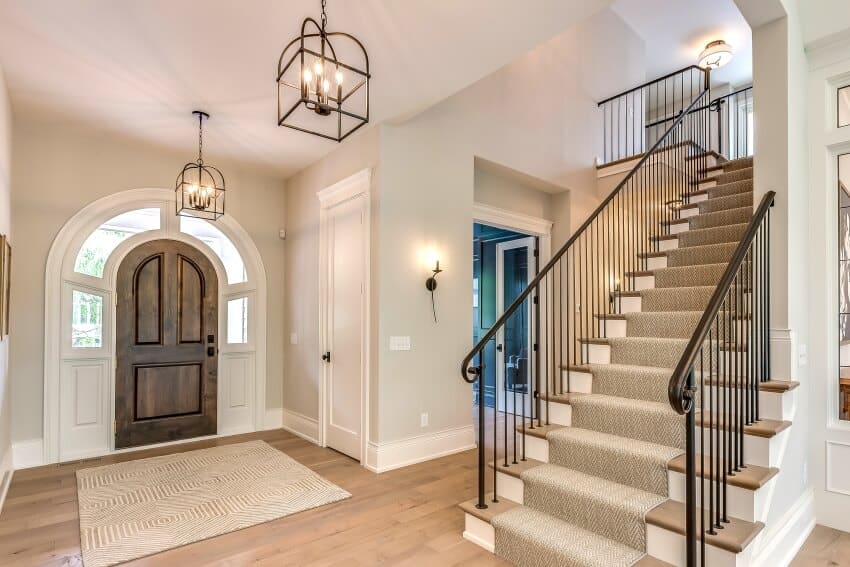
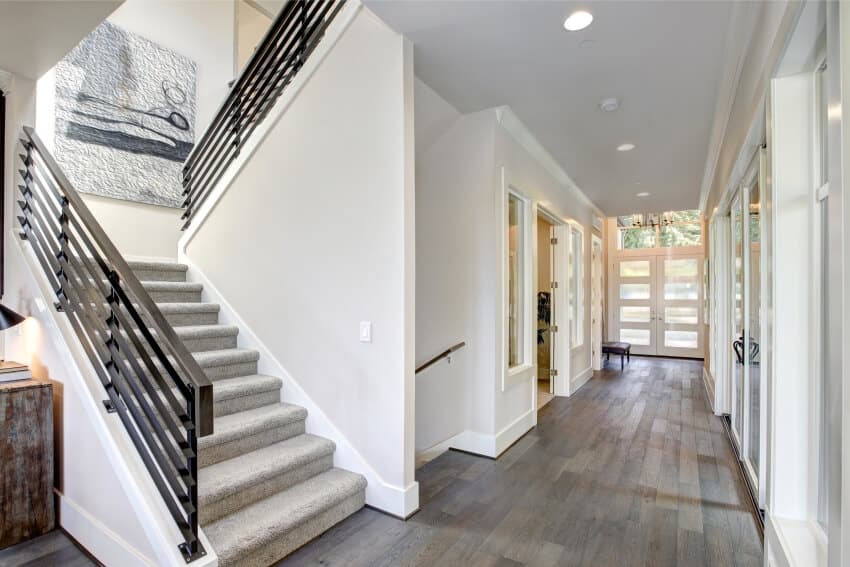
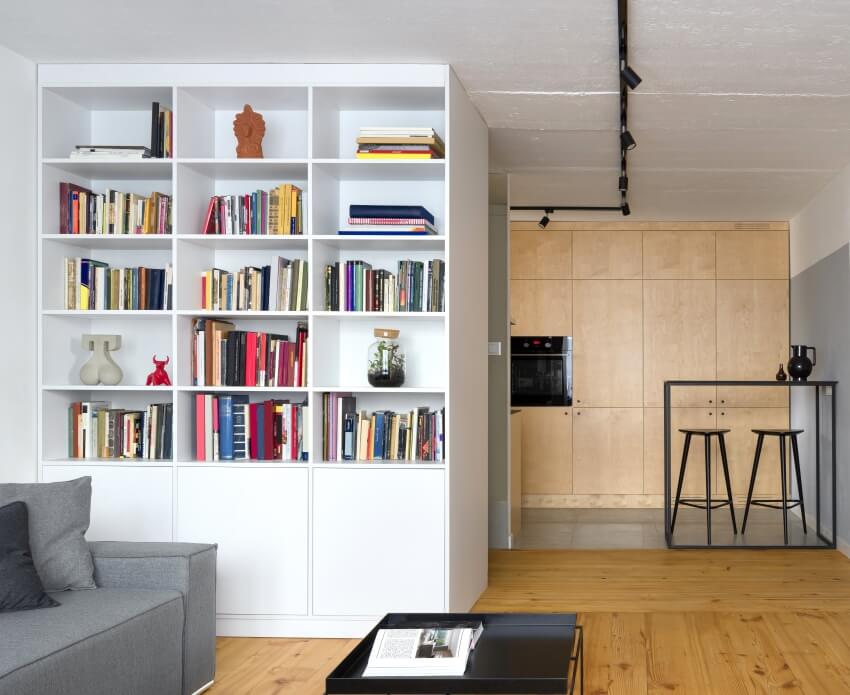
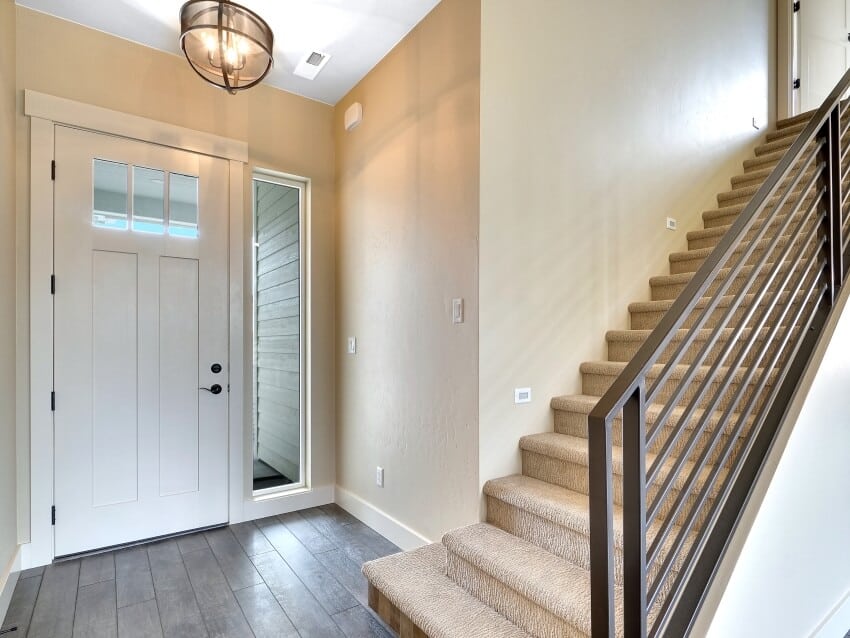
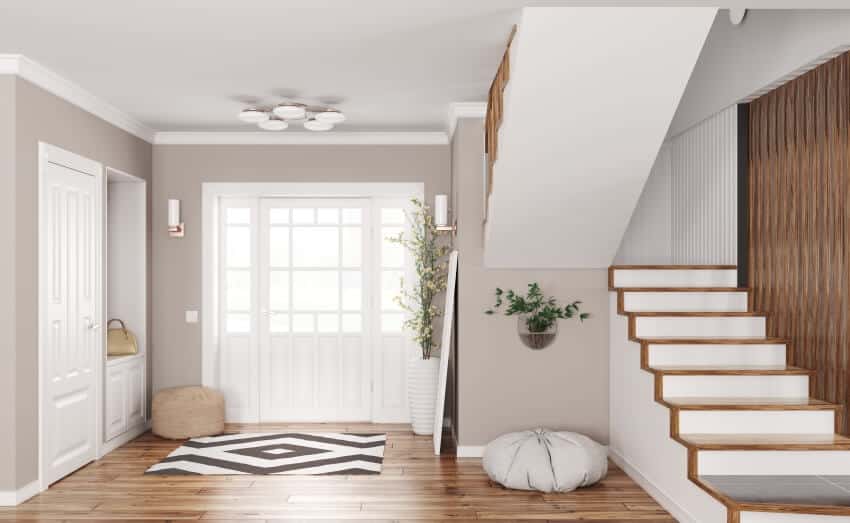 Sconce
Sconce 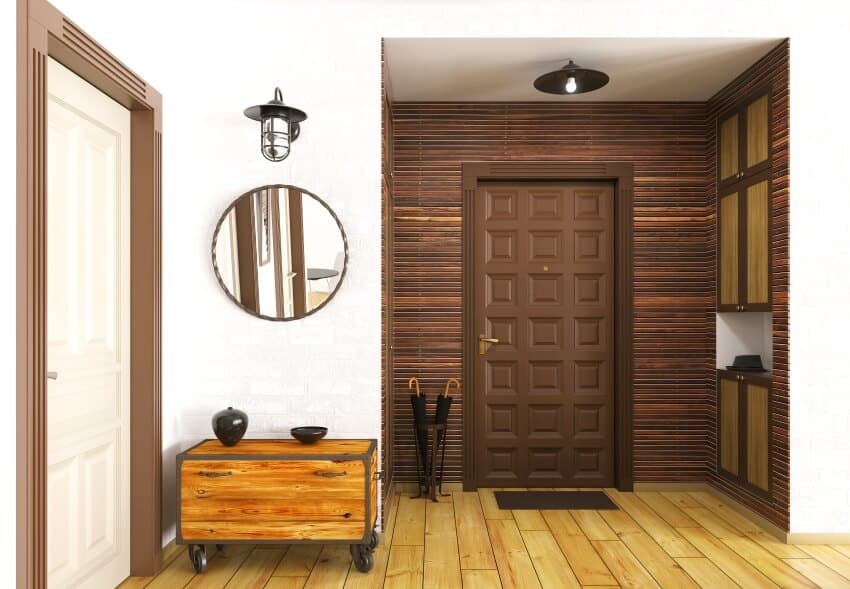
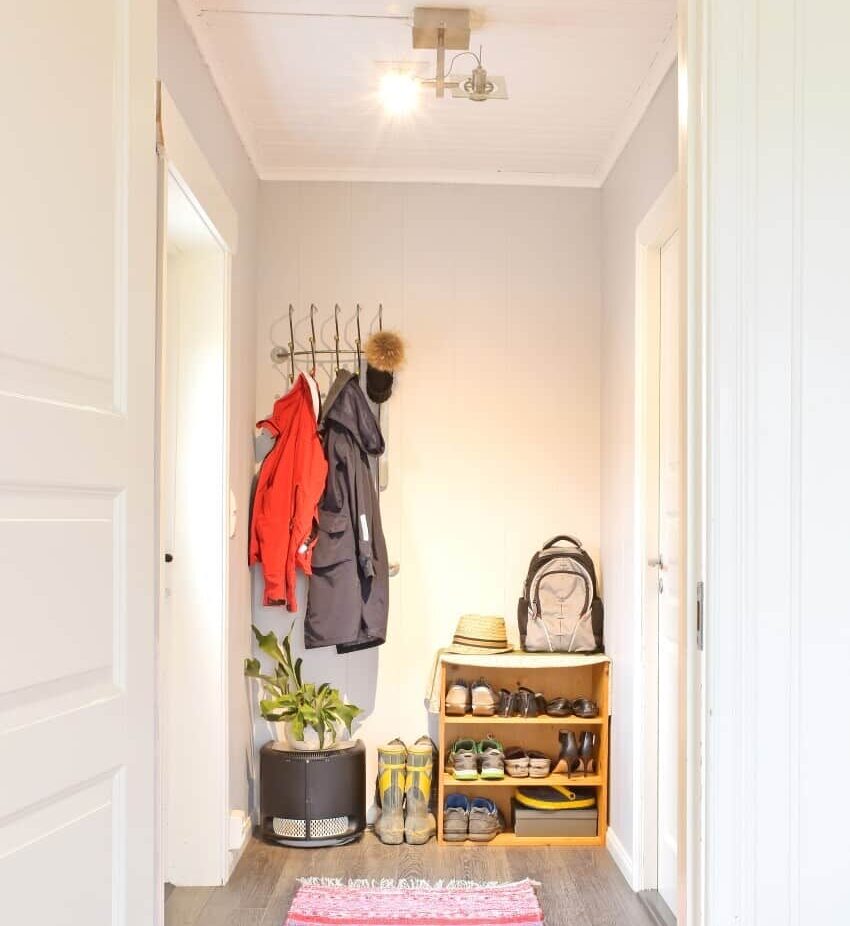
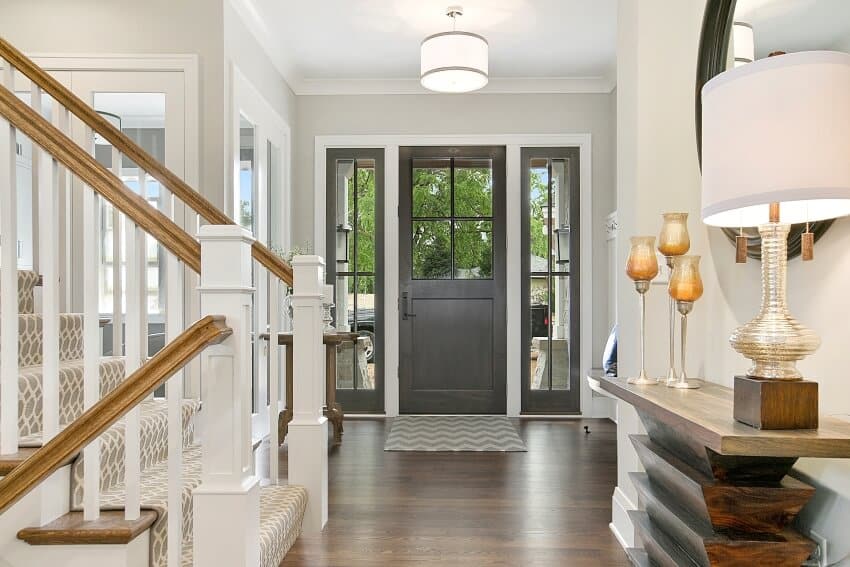
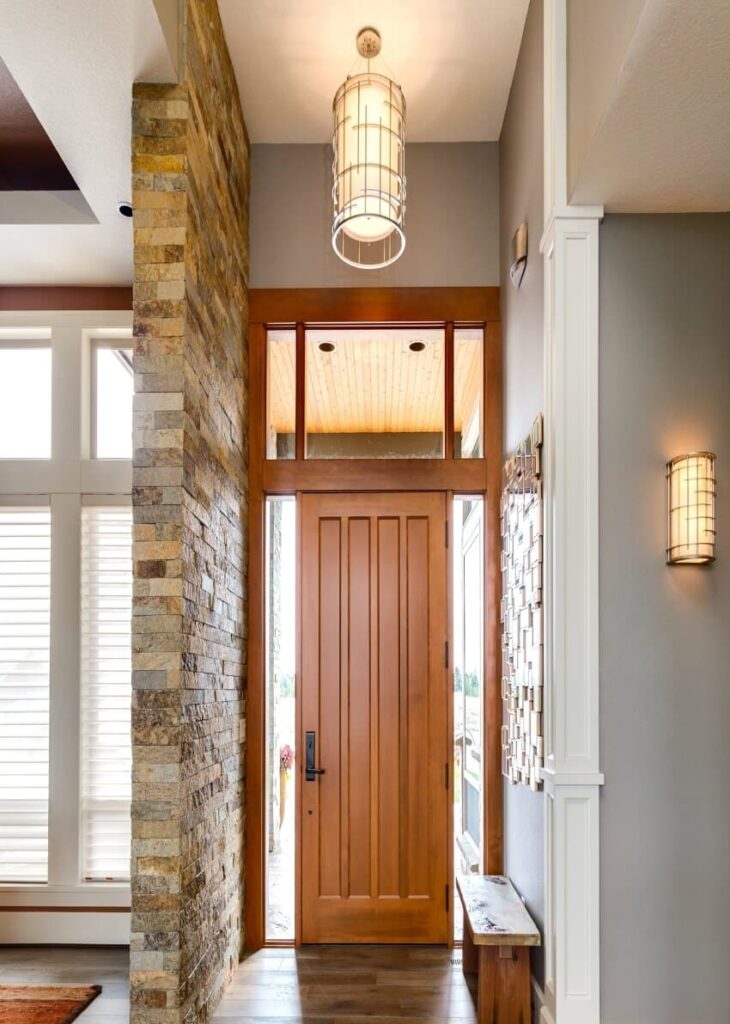 Smart Lights
Smart Lights